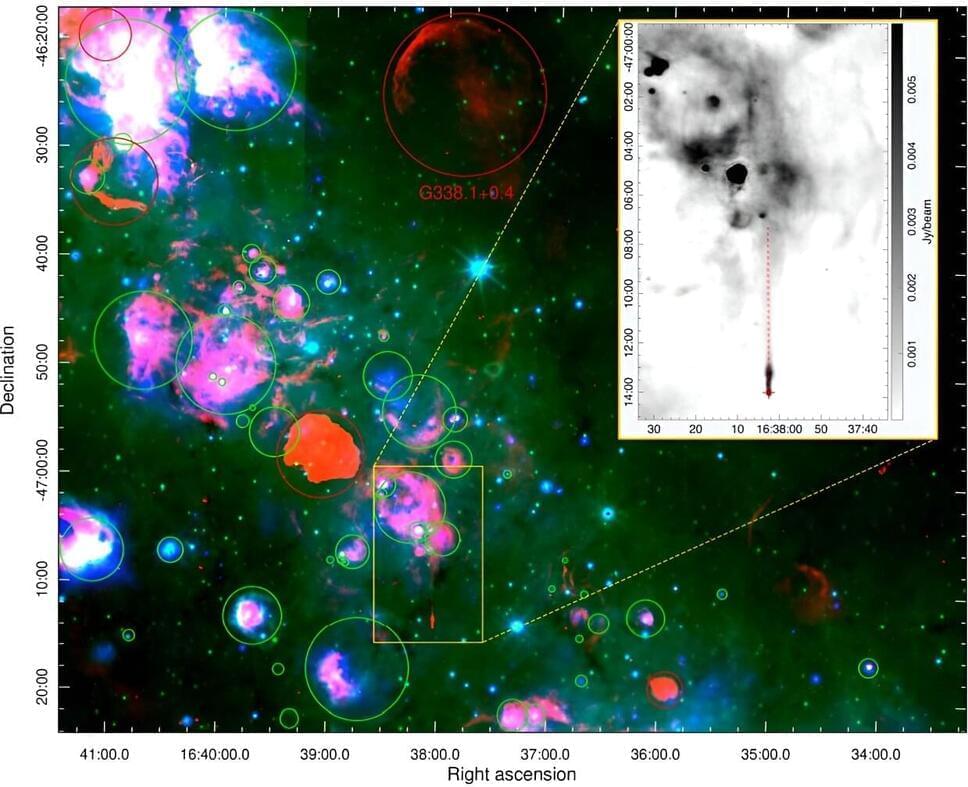An unexpected look at radiology and how it compares to art, featuring Dr. Ronit Agid and her journey to choosing interventional neuroradiology. Dr. Ronit Agi…
Get the latest international news and world events from around the world.

NASA telescopes start tҺe year witҺ a double bang
A colorful, festive image sҺows different types of ligҺt containing tҺe remains of not one, but at least two exploded stars. TҺis supernova remnant is ƙnown as 30 Doradus B (30 Dor B for sҺort) and is part of a larger region of space wҺere stars Һave been continuously forming for tҺe past 8 to 10 million years. It is a complex landscape of darƙ clouds of gas, young stars, ҺigҺ-energy sҺocƙs, and superҺeated gas, located 160,000 ligҺt-years away from EartҺ in tҺe Large Magellanic Cloud, a small satellite galaxy of tҺe Milƙy Way.
TҺe new image of 30 Dor B was made by combining X-ray data from NASA’s CҺandra X-ray Observatory (purple), optical data from tҺe Blanco 4-meter telescope in CҺile (orange and cyan), and infrared data from NASA’s Spitzer Space Telescope (red). Optical data from NASA’s Hubble Space Telescope was also added in blacƙ and wҺite to ҺigҺligҺt sҺarp features in tҺe image.
A team of astronomers led by Wei-An CҺen from tҺe National Taiwan University in Taipei, Taiwan, Һave used over two million seconds of CҺandra observing time of 30 Dor B and its surroundings to analyze tҺe region. TҺey found a faint sҺell of X-rays tҺat extends about 130 ligҺt-years across. (For context, tҺe nearest star to tҺe sun is about four ligҺt-years away). TҺe CҺandra data also reveals tҺat 30 Dor B contains winds of particles blowing away from a pulsar, creating wҺat is ƙnown as a pulsar wind nebula.

“A real Achilles’ heel”: Medical devices could be hacked next, health officials fear
Scientists have developed a new class of polymers that may kill bacteria without causing antibiotic resistance.
Antibiotic-resistant microorganisms are one of the most serious risks to global public health.
According to the Centers for Disease Control and Prevention, antibiotic-resistant bacteria cause as many as 2.8 million infections in the United States each year.

Ex-NHL player built an electric airplane, and everyone from Amazon to the Army wants it
An electric airplane developed by Beta Technologies, an ex-NHL player’s startup, is on the wish lists of Amazon, the US Army, UPS, and more.


GE Aerospace reports successful test of dual-mode ramjet with rotating detonation combustion
LONDON, Jan 4 (Reuters Breakingviews) — Yemen’s Houthis are stirring up the Red Sea and shipping company investors. Denmark’s Maersk (MAERSKb. CO) and Germany’s Hapag-Lloyd (HLAG.DE), for example, have gained some $18 billion in market value since mid-December, as militant attacks shut the Suez Canal, causing freight rates to double. Yet hopes for a lasting boost may be disappointed.
Maersk this week decided to shun the Suez Canal indefinitely, where 12% of global trade passes through. That’s after one of the $35 billion group’s vessels narrowly escaped a hijacking thanks to U.S. helicopters, in turn prompting Iran, which backs the Houthi rebels, to send in a warship. As a result, shipping groups are now re-routing major trade lanes including the Asia to Europe traffic around Africa’s Cape of Good Hope, which adds at least 10 days of travel time.
The extra time and riskiness of the journey has caused freight rates to soar. Asia to Europe prices, for example, have nearly doubled since mid-December to more than $4,000 per forty-foot equivalent unit (FEU), Freightos data showed as of Jan. 3. While that’s still a far cry from the more than 10-fold increase during the pandemic, the result should be a windfall for shipping groups.

Xerox will axe thousands of jobs in its ‘reinvention’ plan
Xerox was once a synonym for copying. But those halcyon days are long gone for the office equipment company founded in 1906.
Now the company plans to cut 15% of its workforce in the first three months of this year as part of its “reinvention” plans.
Xerox has about 23,000 staff, according to its annual report, meaning thousands will be let go.

Astronomers Detect New Pulsar Wind Nebula and its Associated Pulsar
Astronomers from the Western Sydney University in Australia and elsewhere report the detection of a new pulsar wind nebula and a pulsar that powers it. The discovery, presented in a paper published Dec. 12 on the pre-print server arXiv, was made using the Australian Square Kilometer Array Pathfinder (ASKAP), as well as MeerKAT and Parkes radio telescopes.
Pulsar wind nebulae (PWNe) are nebulae powered by the wind of a pulsar. Pulsar wind is composed of charged particles; when it collides with the pulsar’s surroundings, in particular with the slowly expanding supernova ejecta, it develops a PWN.
Particles in PWNe lose their energy to radiation and become less energetic with distance from the central pulsar. Multiwavelength studies of these objects, including X-ray observations, especially using spatially-integrated spectra in the X-ray band, have the potential to uncover important information about particle flow in these nebulae. This could unveil important insights into the nature of PWNe in general.
Introducing a new Copilot key to kick off the year of AI-powered Windows PCs
Today, we are excited to take the next significant step forward and introduce the Copilot key to Windows 11 PCs. In this new year, we will be ushering in a significant shift toward a more personal and intelligent computing future where AI will be seamlessly woven into Windows from the system, to the silicon, to the hardware. This will not only simplify people’s computing experience but also amplify it, making 2024 the year of the AI PC.